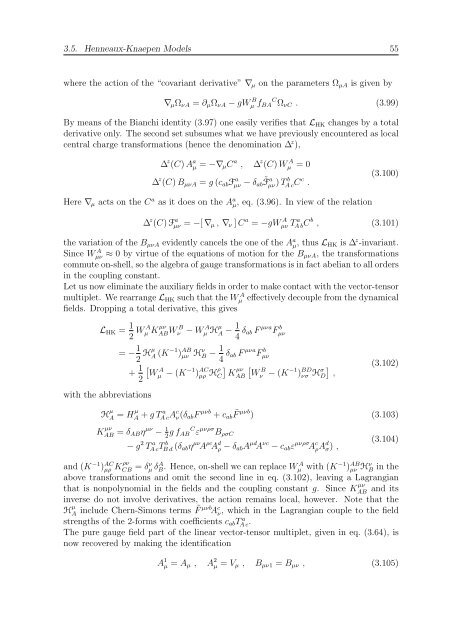N=2 Supersymmetric Gauge Theories with Nonpolynomial Interactions
N=2 Supersymmetric Gauge Theories with Nonpolynomial Interactions
N=2 Supersymmetric Gauge Theories with Nonpolynomial Interactions
Create successful ePaper yourself
Turn your PDF publications into a flip-book with our unique Google optimized e-Paper software.
3.5. Henneaux-Knaepen Models 55<br />
where the action of the “covariant derivative” ∇µ on the parameters ΩµA is given by<br />
∇µΩνA = ∂µΩνA − gW B µ fBA C ΩνC . (3.99)<br />
By means of the Bianchi identity (3.97) one easily verifies that LHK changes by a total<br />
derivative only. The second set subsumes what we have previously encountered as local<br />
central charge transformations (hence the denomination ∆ z ),<br />
∆ z (C) A a µ = −∇µC a , ∆ z (C) W A µ = 0<br />
∆ z (C) BµνA = g (cabF a µν − δab ˜ F a µν) T b A cC c .<br />
Here ∇µ acts on the C a as it does on the A a µ, eq. (3.96). In view of the relation<br />
(3.100)<br />
∆ z (C) F a µν = −[ ∇µ , ∇ν ] C a = −gW A µν T a A bC b , (3.101)<br />
the variation of the BµνA evidently cancels the one of the A a µ, thus LHK is ∆ z -invariant.<br />
Since W A µν ≈ 0 by virtue of the equations of motion for the BµνA, the transformations<br />
commute on-shell, so the algebra of gauge transformations is in fact abelian to all orders<br />
in the coupling constant.<br />
Let us now eliminate the auxiliary fields in order to make contact <strong>with</strong> the vector-tensor<br />
multiplet. We rearrange LHK such that the W A µ effectively decouple from the dynamical<br />
fields. Dropping a total derivative, this gives<br />
LHK = 1<br />
2 W A µ K µν<br />
ABW B ν − W A µ H µ 1<br />
A −<br />
4 δab F µνa F b µν<br />
= − 1<br />
µν H ν B − 1<br />
2 Hµ<br />
+ 1<br />
2<br />
<strong>with</strong> the abbreviations<br />
A (K−1 ) AB<br />
W A µ − (K −1 ) AC<br />
µρ H ρ<br />
C<br />
4 δab F µνa F b µν<br />
K µν<br />
AB<br />
W B ν − (K −1 ) BD<br />
νσ H σ D<br />
,<br />
(3.102)<br />
H µ<br />
A = Hµ<br />
A + g T a A cA c ν(δabF µνb + cab ˜ F µνb ) (3.103)<br />
K µν<br />
AB = δABη µν − 1<br />
2 g fAB C ε µνρσ BρσC<br />
− g 2 T a A cT b B d (δabη µν A ρc A d ρ − δabA µd A νc − cabε µνρσ A c ρA d σ) ,<br />
(3.104)<br />
and (K−1 ) AC<br />
µρ K ρν<br />
CB = δν µ δA B . Hence, on-shell we can replace W A µ <strong>with</strong> (K−1 ) AB<br />
µν Hν B in the<br />
above transformations and omit the second line in eq. (3.102), leaving a Lagrangian<br />
that is nonpolynomial in the fields and the coupling constant g. Since K µν<br />
AB and its<br />
inverse do not involve derivatives, the action remains local, however. Note that the<br />
H µ<br />
A include Chern-Simons terms ˜ F µνbA c ν, which in the Lagrangian couple to the field<br />
strengths of the 2-forms <strong>with</strong> coefficients cabT a A c .<br />
The pure gauge field part of the linear vector-tensor multiplet, given in eq. (3.64), is<br />
now recovered by making the identification<br />
A 1 µ = Aµ , A 2 µ = Vµ , Bµν1 = Bµν , (3.105)

















